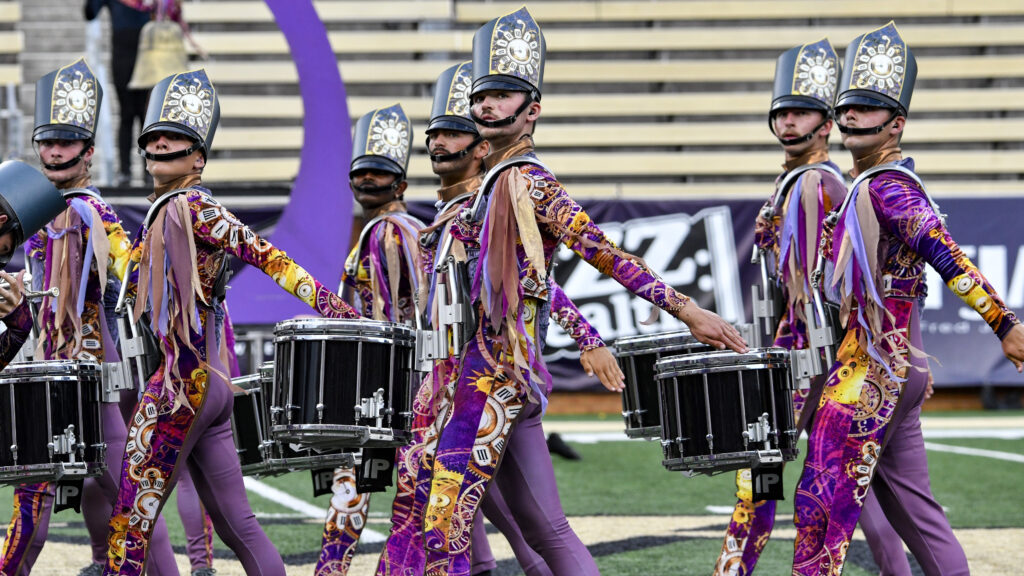Both Drum Corps International and Walt Disney World celebrated 25th anniversaries during the 1997 DCI World Championships. Special DCI events held at Epcot, featured a parade of corps and the annual Individual & Ensemble Showcase at the Disney park. Other anniversary activities were held at Orlando’s Citrus Bowl Stadium during the second of three consecutive visits to the Florida city.
Blue Devils won its ninth DCI Championship this year with “As Time Goes By,” topping the Cadets. Despite falling to the Devils by 9.5 points earlier in the season, Santa Clara Vanguard members gave their Bay Area comrades a scare by tying the Concord corps for first place during the Quarterfinals competition.
Carolina Crown placed 12th, marking the young corps’ third-straight Finals appearance. Crown’s “Postcards from Britain” production was based mostly on music from England.
The show opened with William Walton’s “Crown Imperial,” a march originally written for the 1937 coronation of King Edward VIII, who abdicated the throne prior to the planned coronation to marry an American socialite who had been twice divorced. The coronation went ahead on the planned date, but instead with Edward’s brother, who became King George VI. The work was substantially revised in 1953 and performed the same year for the coronation of Queen Elizabeth II, and was more recently performed at the wedding of Prince William and Catherine Middleton in 2011.

Carolina Crown’s brass players entered the field through three gates that were opened sequentially as each new group passed through, accompanied by color guard members in flowing robes of various regal colors. Three groupings of flags in shades of reds, blues, or greens outlined abstracted crowns.
The next part of the show was the only not based on music from Britain, utilizing composer Bob Margolis’ “Terpsichore” which he wrote in 1981 for wind ensemble. Crown staff members chose the piece because it has the character of music of the British Renaissance. The work, written in four movements, was based on dances composed in 1612 by German Renaissance composer Michael Praetorius, who was known for developing music based on Protestant hymns.
The corps utilized the sprightly Movement IV: “Gaillarde; Volte,” picking it up about halfway through the movement when “Volte” came in. (“Volte” is an old French dance featuring a variety of whirling turns.)
With British flair, some color guard members were costumed in hunting jackets and caps with rifles, as if on a foxhunt, while others donned wide-brim hats and parasols, as if going out for a picnic. Another group wore polo shirts and twirled polo bats before picking up flags the colors of their various shirts, while others wore fencing masks and twirled sabers as if rapier swords.

Following, Edward Elgar’s “Variation IX (Adagio)” from “Enigma Variations,” better known as “Nimrod,” returned from the corps’ 1996 season. Elgar wrote the theme and 14 variations in 1899, titling it, “Variations on an Original Theme for Orchestra, Op. 36.” The work became known as “Enigma Variations” due to the cryptic titles Elgar gave the movements, each which were dedicated to a different friend of the composer.
This particular movement was written in tribute to the composer’s friend, Augustus J. Jaeger, a music editor who encouraged Elgar to continue writing through a period of depression. The subtitle “Nimrod” refers to a character in the Book of Genesis who is “a mighty hunter before the Lord.” Jaeger, German for “hunter,” demonstrates how Elgar’s mind was working when he created the individual titles of his musical enigmas.
The color guard section highlighted the emotional musical swells and tension releases of the elegiac movement by portraying dancers at a regal ball, complete with hoop skirts.
The corps’ closing selection “Gigue” is the fast first movement from Gustav Holst’s “St. Paul’s Suite,” composed in 1812 for the St. Paul’s Girls School string orchestra in West London. Director of music there from 1905 through 1932, Holst wrote the piece in gratitude for the school building him a soundproof writing studio.
A “gigue,” sometimes spelled “jig,” is a 6/8 and 9/8 time signature Scottish/Irish folk music dance. The color guard members focused on the lighter nature of the jubilant music, trading their flags and sabers for elongated triangular checkered banners, the kind you might find hanging from the walls of grand British halls and cathedrals.
1997 Overview

Michael Boo was a member of the Cavaliers from 1975-1977. He wrote about the drum corps activity for more than 35 years while serving as a staff writer for various Drum Corps International projects. During his lifetime Boo wrote for numerous other publications including an honors-winning book on the history of figure skating. He also was an accomplished composer. Boo passed away in November of 2020





